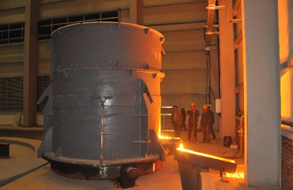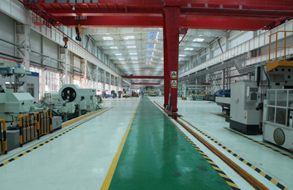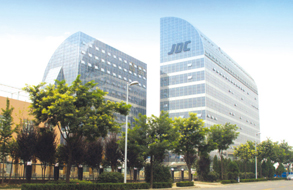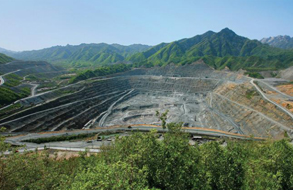Molybdenum prices to climb up in 2018
----Interview with Mr. Liu Junmin
Manager of Market Development Department
Jinduicheng Molybdenum Co., Ltd.
- A state-owned and publically listed Chinese company, Jinduicheng Molybdenum Co., Ltd. ("JDC Ltd.") is a globally leading and Asia's largest molybdenum company engaged in molybdenum resource development, material processing and application-oriented research. It is an executive-directorship member of the International Molybdenum Association (IMOA) and the directorship member of the Molybdenum Branch of China Nonferrous Metals Industry Association (CNIA).
- Asian Metal: Hello, Mr. Liu. Would you please make a brief introduction about your company first?
- Mr. Liu: Headquartered in Shaanxi Xi'an High-tech Development Zone, our company was set up on May 16, 2007 as a joint venture between Jinduicheng Molybdenum Group Co., Ltd. ("JDC Group", the controlling shareholder), Taiyuan Iron and Steel (Group) Co., Ltd. ("TISCO"), CNMC Ningxia Orient Group Co., Ltd. ("Ningxia Orient") and Baosteel Group. Our company has an investment capital of RMB3.2 billion (USD510 million) and over 5,000 employees, and is mainly engaged in molybdenum-related production, trading and research. Its product portfolio consists of three big categories (Mo furnace charges, Mo chemicals and Mo deep processed products) and over 20 varieties, which are widely used in iron and steel smelting, petrochemical, machinery manufacturing, aviation and aerospace, electronic lighting and biopharmaceutical industries. Having grown into a globally renowned brand, JDC Ltd. occupies an about 10% share of the international molybdenum market, with its clients coming from countries in Europe, America, Africa and Australia as well as Japan, South Korea and India in Asia.
- Asian Metal: Would you please make a brief introduction about yourself then?
- Mr. Liu: My name is Liu Junmin, a senior economist and a senior molybdenum analyst. Now I work as Director of Market Development Department of JDC Ltd. I am mainly in charge of marketing management, product image publicity and marketing information analysis. Since I started my career life sixteen years ago, I have long devoted myself into monitoring and research on molybdenum market information. I have been invited to and delivered speeches at key molybdenum industrial meetings and conferences, and have published over 30 articles in related industrial journals such as China Molybdenum Industry, World Nonferrous Metals, China Nonferrous Metals News, China Nonferrous Metals, Stainless Steel Market and Analysis.
- Asian Metal: Would you please give a brief review on history of the Chinese molybdenum market?
- Mr. Liu: The watershed in the Chinese molybdenum history was the year of 2008 when the financial crisis happened. Before 2008 the industry fared ahead in a small and sporadic way, and after that it underwent vehement reshuffling and mergers, with some technically backward companies forced to exit from the market. By now in China there are over 300 molybdenum companies whose sizes have reached a certain level, and of which around thirty are medium-sized and around fifteen are large-sized companies.
- Asian Metal: Over the past ten years, molybdenum concentrate prices in China underwent violent fluctuations, and some medium- and small-sized production companies were eliminated out of the market. What do you think of the Chinese molybdenum concentrate market in the future?
- Mr. Liu: Of Chinese molybdenum concentrate production companies, the majority are companies whose main product is molybdenum while the rest have molybdenum as their side products. China boasts favorable molybdenum deposit conditions and a soundly concentrated molybdenum industry. By now, China has an annual production capacity of around 300,000t of molybdenum concentrate and maintains an annual output of around 200,000t, of which around 40,000t are produced by JDC Ltd., a 20% market share.
- Production costs of molybdenum concentrate basically fall into four categories, RMB1,200/mtu (USD8.68/lb Mo), RMB1,400/mtu (USD10.13/lb Mo), RMB1,600/mtu (USD11.57/lb Mo) and RMB2,000/mtu (USD14.46/lb Mo), based upon their mining conditions. Since latter half of 2017, most Chinese molybdenum concentrate producers keep making profits, and many medium- and small-sized Mo mines and newly-built mines are therefore encouraged to go on stream. But owing to a number of factors including environment, production licensing and taxation, it's quite difficult for them to dramatically increase outputs; and the new-comers in the molybdenum concentrate market are either unable to affect the supply status. So market players have no need to worry too much that molybdenum concentrate outputs will dramatically increase in the market. Instead, with downstream demand keeping increasing, I believe that supply in the Chinese molybdenum concentrate market will remain tight for quite a long time ahead. I believe that the market will still move on with both supply and selling price increasing in 2018.

- Asian Metal: In molybdenum consumption, metallurgical charges amount to quite a large proportion. What do you think of price trend and demand for Chinese ferromolybdenum in 2018?
- Mr. Liu: As a national strategic metal, molybdenum is used in the smelting industry in the form of ferromolybdenum. In China, ferromolybdenum accounts for over 80% of molybdenum consumption and therefore is a quite large market. The majority of Chinese ferromolybdenum producers, over 80%, are located in Liaoning, Henan, Shaanxi and Jiangsu provinces. As ferromolybdenum producers directly contact their end users such as steel mills, their prices fluctuate quite frequently and serve as a wind indicator for prices of the whole molybdenum industry chain. When looking back, we found that in 2016 prices for Chinese ferromolybdenum were still lower than its production costs, but since early 2017 they have risen to above production cost line and ferromolybdenum producers therefore are able to make sound profits.
- Meanwhile, Chinese government also eased limitations on ferromolybdenum export market. China revoked its export tariffs on ferromolybdenum with effect from May 1, 2015, and since then the interrelation between international and Chinese ferromolybdenum market strengthens notably and Chinese ferromolybdenum is sold to a wider region. Moreover, when viewing from the supply-demand perspective, the international market provides favorable macro-environment conditions as in this market demand grows at a higher rate than supply does.
- Regarding downstream demand in China, steel mills constitute the major consumption force for ferromolybdenum. Though Chinese steel mills are pressing on with their capacity-cut reforms, what have been cut are low-end production capacities; on the other hand, the major application fields for ferromolybdenum are high-end business such as stainless steel or special alloy steel. With the steel industry progressing toward a high-end direction, its demand structure will surely be changed and the ferromolybdenum market has a very inspiring outlook.
- As both the Chinese domestic and export markets for ferromolybdenum keep growing, tightness in the supply of upstream molybdenum concentrate becomes increasingly formidable. I feel quite optimistic about the Chinese ferromolybdenum market in 2018, anticipating the following changes for this year:
- 1) Both outputs and sales would grow steadily in comparison to those in 2017, and selling regions would expand notably;
2) Prices would move slowly with interval fluctuations, but would go up on the whole.
- Asian Metal: Would you please make a brief analysis on consumption of molybdenum chemicals in China? What is the growth point in demand for molybdenum chemicals in 2018?
- Mr. Liu: Molybdenum chemical product is an important link in the molybdenum industry chain, mainly consisting of ammonium dimolybdate, tetramolybdate and heptamolybdate as well as sodium molybdate. In China, molybdenum chemicals amounts to around 12% of the total Mo consumption. Their prices are usually calculated with the cost-plus method and follow price fluctuations for metallurgical charges, though it usually takes some time for Mo chemicals' prices to pick up on the latter.

- Demand for sodium molybdate mainly comes from catalyst and metal deep processing industries. In petro-catalytic smelting industry where sodium molybdate is used as a catalyst, molybdenum consumption is linked to international oil prices. During the latter half of 2014, international oil prices plunged and still hover at a low level at present, and accordingly the petroleum industry's demand for sodium molybdenum remain stable, with no major improvements seen. In molybdenum deep processing industry, sodium molybdate is used as raw material to produce molybdenum powder and further molybdenum products. Such products have relatively high added values and low pollution effects; and so environmental policies impose no great effects upon their production and their demand for sodium molybdate is quite stable.
- Sodium molybdate is also used in dye and paint industry, but consumption from this industry is of a small quantity, not a major molybdenum consumption force. So changes in its demand will not bring notable effects upon Mo consumption structure.
- In consideration of these characteristics in production and consumption of molybdenum chemicals, I believe that consumption of Chinese molybdenum chemicals would remain stable on the whole in 2018 and might grow slightly, and prices would follow raw material prices to fluctuate periodically but show a steady upward trend on the whole.
- Asian Metal: With market information becoming more accessible for market players and regional price gap narrowing, what will molybdenum product producers do to enhance their competitive edges?
- Mr. Liu: Molybdenum products mainly consist of four categories, including molybdenum powder, wire, rod and bar. The market is of small size, amounting to only 8% of the total Mo consumption. Take molybdenum powder for example, the national total production capacity for the material is about 20,000t and there are nearly 30 production companies across China, of which JDC Ltd. has an annual capacity of 4,200t or a 21% market share. So the Chinese molybdenum powder industry is a quite concentrated one.
- The molybdenum product market has the following characteristics: a large number of product varieties, small quantity, small production size, great price gap between different product brands, and producers compete mainly depending upon their comprehensive production costs. This is why small-sized molybdenum product producers have stronger competitive strength.
- It usually takes some time for prices of molybdenum products to catch up with price fluctuations in raw material prices, and competition in molybdenum product market is mainly decided by differences in production costs of different producers. In consideration of characteristics of Chinese molybdenum product market, I have three suggestions on how to sharpen up competitive edges of Mo product producers.
- 1) Internal improvement: producers should keep improving their production techniques and cut costs;
2) Downstream application: producers should try to expand downstream application of their products and develop new varieties of high-end products;
3) Market alliance: producers should set up information-sharing mechanisms in order to avoid price competition and to achieve win-win results.
- Asian Metal: As a senior molybdenum market participant, how do you think the Chinese molybdenum market will move ahead in the future?
- Mr. Liu: The Chinese molybdenum industry greatly needs support from government in its development as molybdenum is a national strategic metal. At present, Chinese government has strict environmental and taxation requirements on the molybdenum industry, and affected by these factors, production costs for molybdenum producers keep increasing. But opportunities also exist for Chinese molybdenum companies as market demand is great. Energy-saving and green and sustainable development model should be the development strategy for them, and I have the following suggestions:
- 1) Be oriented by the market, maintain legal operation, improve anti-pollution capacity and realize green and sustainable development;
2) Innovate and upgrade production techniques, and expand downstream applications;
3) Compete in a fair and sustainable way, and cooperate to win a greater say in the international molybdenum market;
4) Set up molybdenum industrial alliance to facilitate healthy and coordinated development of the whole industry.
- In sum, we feel confident about development of the Chinese molybdenum market in the future.
- Asian Metal: Thanks very much for sharing your views with us and also for your support for Asian Metal. Wish your company better and better!




